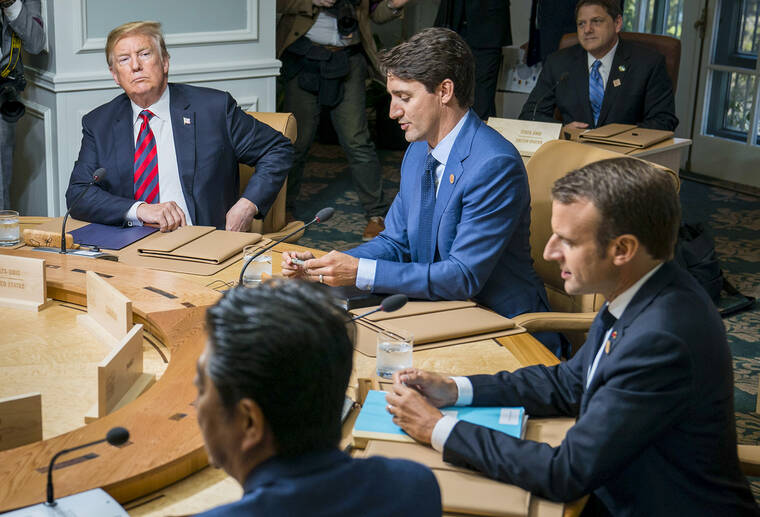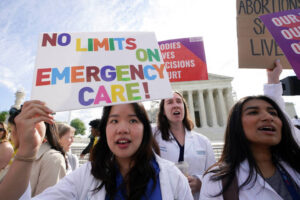Trump leaves European leaders praying for a low-drama summit
WASHINGTON — The last time European leaders came together for a diplomatic gathering in Canada, it didn’t go so well.
At the Group of 7 meeting in 2018, a photo of a glowering President Donald Trump, arms crossed as he was lectured by the German chancellor, went viral. At the end of the summit, in a tweet, Trump accused the Canadian prime minister of being “dishonest & weak” for vowing to retaliate against U.S. steel and aluminum tariffs. Then he ripped up the agreement the leaders had just signed.
ADVERTISING
This year, as the European leaders head to Canada again, with Trump back in office, they are hoping to avoid something even worse.
“The previous G7 summits, as well as NATO summits, were sort of awkward family gatherings,” said Max Bergmann, the director of the Europe, Russia and Eurasia program at the Center for Strategic and International Studies. “The question now, I think, is not so much, ‘Is this an awkward family gathering?’ I think the question is, ‘Is this still a family?’”
Israel’s surprise attacks on Iran’s leadership and nuclear facilities Friday are likely to scramble the planned agenda at this year’s three-day summit in the mountains of western Canada.
The leaders of the G7 countries — Britain, Canada, France, Germany, Italy, Japan and the United States — now will have to confront the fallout from another war in the Middle East: increased instability, surging oil prices and the possibility that Iran will respond with new terror attacks around the world.
But thanks to Trump’s return to power, European leaders remain at a crossroads: Is there any hope that Europe’s future can still be one that resembles the past 75 years, with America as an essential partner with shared values and security interests? Or does Trump’s “America First” foreign policy mean that the continent’s nations are irrevocably destined to forge a separate path from an ally that has veered from the post-World War II alliance?
Those questions have been at the center of separate meetings Trump has had with the leaders of Germany, France, Britain and others. But the Canada summit will be the first test of the leaders’ group dynamics during the president’s second term.
“The best-case scenario, in my mind, coming out of this is that there’s no real blowups,” said Josh Lipsky, the chair of international economics at the Atlantic Council.
The leaders of the G7 countries and the presidents of the European Council and Commission, who will also be in attendance, have substantive issues they plan to raise when they convene in Kananaskis, Alberta, on Sunday.
Support for Ukraine is on the agenda, along with a plan to make it harder for President Vladimir Putin of Russia to make money on the sale of oil around the world.
European leaders also expect Trump to repeat his demand that their countries spend 5% of their budgets on defense, a target that would substantially shift the military burden from the United States to other NATO members. And they want to cautiously discuss with Trump the tariffs he has imposed around the world.
But because the relationship between Trump and Europe has gotten off to such an adversarial start during his second term, the primary effort by the Europeans is to simply avoid topics that might set off the kind of angry response that doomed the 2018 summit. There will be almost no mention of climate change and little to no discussion of migration — two topics that divide the Europeans from Trump. Instead, they are expected to try and stroke the president’s ego by vowing to deliver on his military spending demand.
Analysts who follow the negotiation process closely, including Lipsky and Rachel Rizzo, a senior fellow at the Atlantic Council’s Europe Center, say the leaders may not issue a joint statement at the end of the summit, bowing to the reality that it will be difficult to reach consensus with Trump on a range of issues. If that happens, it would be a striking concession for the group, which was founded on a pledge to find a way for the world’s largest democracies to speak with one voice.
But Rizzo said the decision by the Europeans to avoid a serious clash with Trump was a logical one.
“If there’s something that the United States is, at least right now, vastly opposed to, it’s probably not helpful to put that on the agenda, knowing that it will create tensions in moments like this,” she said.
In the run-up to the summit, the European leaders had hoped that their best chance for some agreement with Trump might be a plan to pressure Putin to end the war with Ukraine by forcing Russia to sell its oil at a lower price. Currently, the sale of Russian oil is capped at $60 a barrel; the Europeans want to push that down to $45 or even lower.
That plan may be more complicated following Israel’s attacks, which quickly drove up the price of oil because of concerns that another significant war in the Middle East could restrict the flow of oil around the world.
Trump has not indicated yet whether he supports the European idea. The global effort to impose limits on the sale of Russian oil was developed in part by former President Joe Biden. Some members of the Trump administration had already been concerned that more limits on Russian oil could affect the price of gas for American consumers.
The most delicate subject on the agenda is likely to be the tariffs that Trump has imposed on European countries.
Prime Minister Keir Starmer of Britain negotiated a deal with Trump in May to slash some of the U.S. tariffs on aluminum, steel and cars. But the deal has not yet been implemented, causing frustration in Britain. And the European Union has been locked in a tense back and forth over tariffs with Trump, who has a history of saying that the bloc was formed “to screw the United States.”
Ursula von der Leyen, the president of the European Commission, will be attending the summit and is the only major leader in Europe who has not yet met with Trump one on one. Bergmann, of the Center for Strategic and International Studies, said that despite her threats to use Europe’s economic power to retaliate against the U.S. tariffs, von der Leyen was unlikely to pick a fight.
“She’s also in a tight spot, not wanting to sort of be seen as provoking a confrontation,” he said.
Lipsky, of the Atlantic Council, agreed.
“The dynamic to watch,” he said, “is how Trump engages with President von der Leyen on the one hand, and then the member state leaders there at the same time.”
“What you need,” he added, “is at least a productive weekend where everyone has conversations.”
This article originally appeared in The New York Times.
© 2025 The New York Times Company





